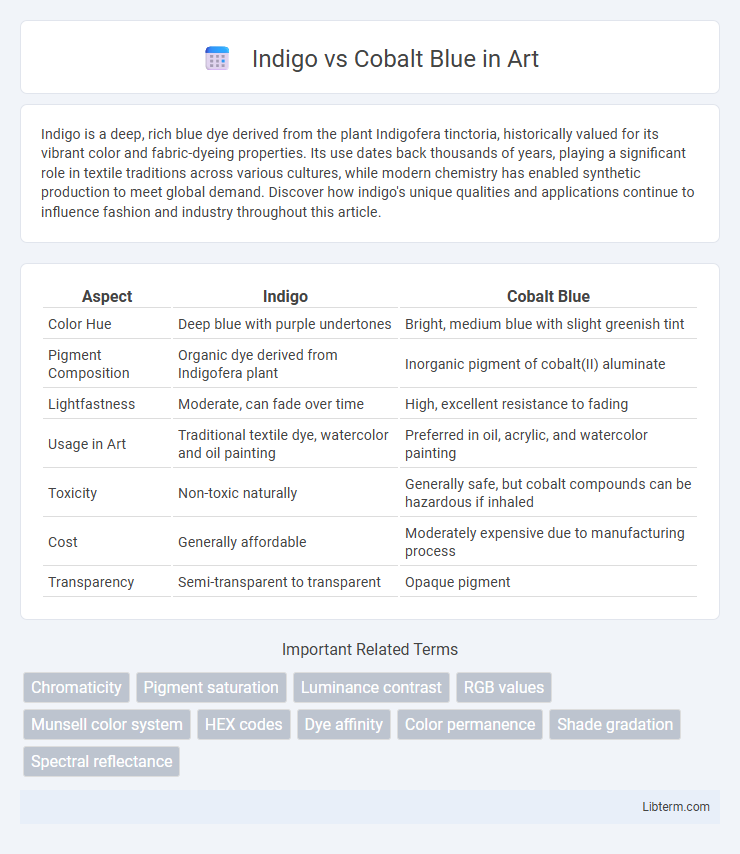Indigo is a deep, rich blue dye derived from the plant Indigofera tinctoria, historically valued for its vibrant color and fabric-dyeing properties. Its use dates back thousands of years, playing a significant role in textile traditions across various cultures, while modern chemistry has enabled synthetic production to meet global demand. Discover how indigo's unique qualities and applications continue to influence fashion and industry throughout this article.
Table of Comparison
| Aspect | Indigo | Cobalt Blue |
|---|---|---|
| Color Hue | Deep blue with purple undertones | Bright, medium blue with slight greenish tint |
| Pigment Composition | Organic dye derived from Indigofera plant | Inorganic pigment of cobalt(II) aluminate |
| Lightfastness | Moderate, can fade over time | High, excellent resistance to fading |
| Usage in Art | Traditional textile dye, watercolor and oil painting | Preferred in oil, acrylic, and watercolor painting |
| Toxicity | Non-toxic naturally | Generally safe, but cobalt compounds can be hazardous if inhaled |
| Cost | Generally affordable | Moderately expensive due to manufacturing process |
| Transparency | Semi-transparent to transparent | Opaque pigment |
Introduction to Indigo and Cobalt Blue
Indigo and cobalt blue are two distinct pigments with rich histories and unique chemical compositions. Indigo, derived from the plant Indigofera tinctoria, is a deep blue dye traditionally used in textiles, particularly in denim production. Cobalt blue, a synthetic pigment made from cobalt salts and aluminum oxide, is prized for its vibrant, intense hue used extensively in art and ceramics.
Origin and History of Indigo
Indigo, derived from the plant Indigofera tinctoria, has been used as a natural dye for over 6,000 years, originating in ancient India and later spreading to Egypt and Mesopotamia. It played a significant role in trade and cultural exchanges, with its deep blue dye highly prized for textiles in Asia, Africa, and Europe. Unlike cobalt blue, a pigment produced from cobalt salts dating back to ancient China, indigo's historical significance lies in its organic, plant-based extraction and long-standing economic importance.
Origin and History of Cobalt Blue
Cobalt blue, a vibrant blue pigment first synthesized in the early 19th century by French chemist Louis Jacques Thenard, originated from the mineral cobalt arsenate discovered in the Ore Mountains of Central Europe. This pigment quickly gained prominence for its intense color stability and resistance to fading, making it a preferred choice in European porcelain and oil painting traditions. The historical use of cobalt compounds dates back to ancient Persia and Egypt, but the modern synthetic cobalt blue marked a breakthrough that influenced art and industrial applications globally.
Chemical Composition and Production
Indigo is an organic dye derived primarily from the plant Indigofera tinctoria, containing the chemical compound indigotin (C16H10N2O2), which is synthesized through a fermentation process or chemical synthesis during production. Cobalt blue is an inorganic pigment composed of cobalt(II) aluminate (CoAl2O4), produced by high-temperature sintering of cobalt oxide and aluminum oxide powders. The differences in chemical composition result in indigo being soluble in organic solvents for textile dyeing, whereas cobalt blue is valued for its stability and non-solubility in water, making it ideal for ceramics and paints.
Color Characteristics and Differences
Indigo is a deep, rich color situated between blue and violet on the color spectrum, known for its dark, slightly purplish hue and calming, introspective qualities. Cobalt Blue, a brighter and more vibrant shade, exhibits a pure, intense blue with high light reflectance, often associated with clarity and energy. While indigo leans towards a muted, subdued tone, cobalt blue stands out with its vividness and brightness, making it ideal for dynamic artistic expressions.
Usage in Art and Design
Indigo and cobalt blue are both prized pigments in art and design, with indigo commonly used for textiles and digital media to evoke deep, rich hues associated with creativity and spirituality, while cobalt blue is favored in painting and ceramics for its vibrant, intense color that offers excellent lightfastness and versatility. Indigo's organic origin makes it a popular choice in traditional dyeing techniques and fashion design, whereas cobalt blue's synthetic form allows for consistent saturation in fine art paints and decorative glazes. Their usage reflects distinct aesthetic intentions: indigo crucial for moody, atmospheric effects and cobalt blue for bright, bold statements in various visual compositions.
Application in Fashion and Textiles
Indigo offers a deep, rich hue prized in denim production and traditional Japanese textiles, providing durability and a timeless aesthetic. Cobalt blue presents a brighter, more vibrant shade frequently used in high-fashion fabrics and modern sportswear, enhancing visual appeal with its electric intensity. Both dyes provide unique colorfastness properties crucial for long-lasting textile applications in their respective fashion niches.
Cultural and Symbolic Meanings
Indigo symbolizes intuition, spirituality, and deep contemplation, often associated with wisdom and inner knowledge in many cultures, especially in Indian and African traditions. Cobalt blue represents trust, loyalty, and calmness, frequently linked to stability and serenity in Western art and design. Both colors carry profound cultural significance, with indigo's mystery and cobalt blue's clarity shaping their symbolic roles across different societies.
Environmental Impact and Sustainability
Indigo dye, extracted from the Indigofera plant, is biodegradable and renewable, making it a more sustainable choice compared to cobalt blue, which is derived from cobalt mined through environmentally harmful processes. Cobalt mining often results in habitat destruction, soil and water contamination, and significant carbon emissions, contributing to a larger ecological footprint. Sustainable practices in indigo cultivation and organic dyeing methods further reduce water usage and chemical pollution, enhancing its environmental advantages over synthetic cobalt blue pigments.
Choosing Between Indigo and Cobalt Blue
Choosing between indigo and cobalt blue depends on the desired intensity and mood in a design or artwork. Indigo offers a deep, rich hue with a slight purple undertone, ideal for creating a sense of mystery or sophistication. Cobalt blue provides a brighter, more vibrant shade that evokes energy and clarity, making it perfect for lively and dynamic compositions.
Indigo Infographic

 libterm.com
libterm.com